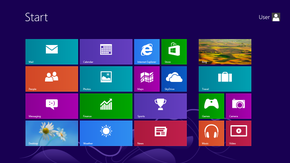Microsoft have budgeted $1,5 billion for marketing Windows 8, and despite a lot of interest, I haven't read to many positive reviews. Windows 8 comes in many forms, and is part of Microsoft's strategy to revitalize the Redmond Giant's fortunes. Microsoft are traditionally a software company, and Windows has been the most popular operating system in the world for the last 25 years (if not longer). Their Office suite is also used by almost every major company in the world, and is the cornerstone of all enterprise personal computing. So why would they make such a radical change as they have with Windows 8? Simple. Apple. Their competition over at Cupertino introduced the iPhone in 2007 and have grown to be not only the most powerful company in technology, but also the most valuable public company in the world. And so the new strategy was born: copy everything Apple has done.
It started with Windows Phone 7, which got a lot of good reviews for its tile based UI, but didn't catch the imagination of Joe Public. And so Microsoft dumped Phone 7, and re-wrote the OS to create Windows Phone 8, carrying over the UI, but ending the update life of any phones they had managed to sell. Simultaneously they were developing a UI for their new Windows 8 operating system, and this is where they deviated from Apple's strategy, and where I believe they have made a huge mistake!
Apple introduced iOS (originally iPhone OS) in 2007, for the iPhone. In 2010 they adapted it for the first iPad. Apple's operating system for laptops and desktops is known as OS X, and is completely separate. However, following the success of the iPhone and iPad, they have gradually incorporated aspects of iOS into OS X, to take advantage of the "halo" effect of these successful devices. This has worked for them, and Mac usage has steadily increased in a shrinking market.
However, Microsoft did not adapt Windows Phone 8 for use on their tablets, and instead developed a version of Windows 8 (Windows RT) to run on the ARM processors typically used in mobile devices. Their will also be more powerful tablets running x86 processors, and these will use the same version of Windows 8 that will be used on desktops and laptops.
The thinking at Redmond is that there will be a trickle down effect. They practically own the desktop/laptop market, especially in enterprise, so you'll eventually be forced into using a Windows 8 machine. Once that happens, people will automatically purchase tablets and phones running the now familiar UI.
Now this might sound OK, but the problem is that tablets differ hugely from desktops and laptops. Tablets use a touch interface that is just not viable on a desktop and to a lesser extent a laptop. Most of the complaints about Windows 8 on PCs revolves around the new Start screen and the use of the live tiles, the very aspect that get so many complements on phones like the Lumia 920 running WP8. On a PC, the tiles seem misplaced, and are an irritating layer over the traditional desktop screen. On a non-touch screen machine, the UI has become illogical, and requires all sorts of not so obvious mouse actions to navigate.
Microsoft could have easily avoided this with a slightly more cautious approach. The tiles could have perhaps been built into the desktop screen for machines without a touch interface, with the option to turn them off altogether. Instead, they have forced this upon us, and the result: 42% of prospective buyers going Apple, according to a recent survey.
Thanks for reading.



Great post. I used to be checking continuously this blog and I'm inspired! Extremely helpful info specifically the remaining phase :) I deal with such info much. I used to be seeking this certain information for a very lengthy time. Thanks and best of luck.
ReplyDeleteAlso visit my web site ... cost of dental implants
This is my first time pay a visit at here and i am genuinely impressed to
ReplyDeleteread all at alone place.
Also visit my web-site; dental plan